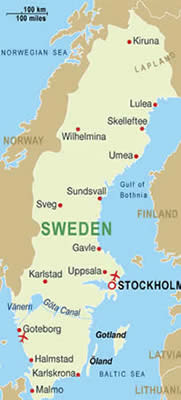
Swedish
Swedish (Svenska) belongs to the East Scandinavian group of the Germanic branch of the Indo-European language family. It is primarily spoken in Sweden, but also spoken in Canada, Estonia, Finland, Norway, United Arab Emirates, and USA. The worldwide population of speakers of Swedish is estimated to be around 9.2 million people (Ethnologue).
Swedish is closely related to Norwegian and Danish. The three languages developed from Old Norse which was spoken in the areas of Scandinavia that are now Norway, Denmark and Sweden. To this day, Danes, Norwegians, and Swedes can talk to each other without an interpreter. Despite the high degree of mutual intelligibility it would not be correct to call the three languages dialects, because Danes, Norwegians, and Swedes see these languages as standardized official languages of their respective countries with separate norms for speaking and writing.
Status
- Sweden
Swedish is the de facto national language of Sweden, where it is spoken by 8.8 million people. It is the primary language for the majority of Sweden’s citizens. - Finland
In Finland, both Swedish and Finnish are official languages. Swedish is a mandatory subject in all Finnish schools. - European Union
Swedish is one of the official languages of the European Union.
Dialects
Swedish is generally divided into three main dialect areas:
- Northern Swedish (Norrland)
- Eastern Swedish (Finland Swedish, Estonian Swedish)
- Svea, Gutniska (Gutamal, Gotlandic, Gutnic)
Standard Swedish is based on the Svea variety spoken in Stockholm, Uppsala, Lund, Gothenburg, and Helsinki. It is cultivated through the Svenska språknämnden, the official Swedish language board that sets standards for the language.
Structure
Sound system
There are some differences in pronunciation among the various dialects of Swedish, particularly in the pronunciation of vowels. The description below is based primarily on Standard Swedish.
Vowels
Swedish has a basic inventory of nine long and nine short vowels. Vowel length makes a difference in word meaning. In the table below, it is indicated by a colon after the vowel. Two front vowels can be unrounded or rounded. Rounded vowels are pronounced with rounded, protruding lips.
| Unrounded | Rounded | Unrounded | Rounded | ||
| i | y | u: | |||
| e | ø | o: | |||
| ɛ | ɔ | ||||
|
Open
|
ɑ | ||||
/y/ has no equivalent in English
/ø/ has no equivalent in English
/ɛ/ = e in bed
/ɔ/ = vowel in thought
/ɑ/ = o in hot
Consonants
The consonant system of Swedish is considerably simpler than its vowel system
| voiceless | p | t | k | ||||
| voiced | b | d | g | ||||
| voiceless | f | s | ɕ | ɧ | h | ||
| m | n | ŋ | |||||
| l | |||||||
| r | |||||||
| j |
- Initial /p, t, k/ are aspirated, i.e., pronounced with a puff of air accompanying their release, but unaspirated when preceded by /s/, just like in English.
- /ɕ/ =close to ch in the German pronunciation of Ich ‘I’
- /ɧ/ is a somewhat unusual consonants whose closest approximation is probably the sign of relief ‘phew!’.
- /ŋ/ =ng in song
Stress and pitch
Swedish is distinguished by its prosody that includes both word stress and tone. It has a pitch accent that differentiates between words that are otherwise identical words. There are two patterns. Pitch accent varies throughout the Swedish-speaking area, and is completely absent in Swedish varieties spoken in Finland. There are two patterns.
- Tone 1: rising + falling, e.g., andén ‘the duck’
- Tone 2: double rising + falling, e.g., andèn ‘the spirit’
Grammar
Medieval Swedish had a more complex grammar than modern Swedish. Nouns, adjectives, pronouns and certain numerals were inflected in four cases (nominative, genitive, dative, accusative) and two genders. Today there are only two cases (nominative and genitive). The verb system was also more complex. By the 16th century, the case and gender systems of the colloquial spoken language had been largely reduced to the two cases and two genders, and the verbs lost their conjugation.
Modern Swedish grammar has the following main features:
Nouns, adjectives, articles, and pronouns
- Gender and number are conflated into one ending.
- Nouns have two grammatical genders: common and neuter. For the most part, gender is not predictable. Inanimate objects are usually neuter. Genders are marked by accompanying modifiers and referential pronouns, and by the forms of the plural, e.g., dag ‘day’ — dagar ‘days’.
- There are two numbers: singular and plural.
- The definite and indefinite articles agree with the noun in gender and number in the singular, e.g., en dag ‘a day’, dagen ‘the day’, dagarna ‘the days’.
- There are no case markings, except for the possessive –s, e.g., dags ‘day’s.’
- Adjectives have no case endings but are marked for definiteness, gender, and number.
- There are strong and weak adjectives. In the strong form, a distinction is made between the common gender, e.g., en gammal man ‘an old man’ and neuter gender ett gammalt hus ‘an old house.’ In the weak declension, there is one general form for both genders, e.g., den gamla mannen ”the/that old man’ and det gamla hus ‘the/that old house‘.
- The pronominal system is very similar to English. Following the reform in the late 60s, du is used to address everyone, except the royal family.
Verbs
- Verbs are not marked for person or number.
- Verbs can be weak or strong. Weak verbs add endings to the root of the verb to form the preterit. Strong verbs undergo a vowel change in the root, often with no ending added. There are several classes of strong verbs.
- The perfect and pluperfect tenses are formed with the auxiliary har ‘have’, e.g., har sett ‘have seen’, hade set ‘had seen’.
- There are three moods: indicative, imperative, and subjunctive.
- There are three voices: active, middle, and passive.
Word order
The normal word order in declarative sentences is Subject-Verb-Object. In questions, the word order is Verb-Subject-Object.
Vocabulary
The basic vocabulary of Swedish is mostly derived from Old Norse. The language has also borrowed words from Middle Low German, and more recently from English. Much of the religious and scientific vocabulary is of Latin and Greek origin, often borrowed through French. New words are mostly formed by compounding. This can result in very long words, e.g., nagellacksborttagningsmedel ‘nail polish remover’.
Below are some common Swedish phrases and words.
| Hello. | Hej. |
| Good day. | Goddag. |
| Good bye. | Hej då. |
| Please. | Tack, snälle* |
| Thank you. | Tack. |
| Excuse me. | Ursäkta. |
| Yes. | Ja. |
| No | Nej. |
| Man | Man. |
| Woman. | Kvinna. |
*To order a glass of milk in a restaurant use Tack, but at someone’s house use Snälla.
Below are the numerals 1-10 in Swedish.
|
1
|
2
|
3
|
4
|
5
|
6
|
7
|
8
|
9
|
10
|
|---|---|---|---|---|---|---|---|---|---|
|
ett
|
två
|
tre
|
fyra
|
fem
|
sex
|
sju
|
åtta
|
nio
|
tio
|
Writing
Swedish and Danish became standardized languages earlier than Norwegian. They became independent when the Bible was translated into each of them during the Reformation.
Today, Swedish is written with a Latin-based alphabet consisting of 29 letters. Beside the 26 letters of the Latin alphabet, it contains three additional letters representing the vowels å, ä, ö, and traditionally listed at the end of the alphabet.
|
A a
|
B b
|
C c
|
D d
|
E e
|
F f
|
G g
|
H h
|
I i
|
J j
|
K k
|
L l
|
M m
|
N n
|
O o
|
|
P p
|
Q q
|
R r
|
S s
|
T t
|
U u
|
V v
|
W w
|
X x
|
Y y
|
Z z
|
Å å
|
Ä ä
|
Ö ö
|
Take a look at Article 1 of the Universal Declaration of Human Rights in Swedish.
| Allmän Förklaring om de Mänskliga Rättigheterna Artikel 1. Alla människor är födda fria och lika i värde och rättigheter. De är utrustade med förnuft och samvete och bör handla gentemot varandra i en anda av broderskap. |
| Universal Declaration of Human Rights Article 1 All human beings are born free and equal in dignity and rights. They are endowed with reason and conscience and should act towards one another in a spirit of brotherhood. |
Did You Know?
English has borrowed a few words from Swedish. Among them are the following:
|
English
|
from Swedish
|
|---|---|
| moped | mo (motor) + ped (pedaller) ‘pedal cycle with engine and pedals’ |
| ombudsman | ombudsman, literally ‘commission man’ (in reference to the office which hears and investigates complaints by individuals against abuses of the state) |
| smorgasbord | smorgasbord ‘open sandwich table’, literally ‘butter-goose table,’ from smorgas, which is said to mean ‘bread and butter’, but is compounded from smor ‘butter’ and gas, literally ‘goose’ which is said to have a secondary meaning of ‘a clump (of butter).’ The final element is bord ‘table’. |
| tungsten | tungsten ‘calcium tungstate’, coined by its discoverer, Swedish chemist Karl Wilhelm Scheele from tung ‘heavy’ + sten ‘stone’. |
Difficulty

Swedish is considered to be a Category I language in terms of difficulty for speakers of English.